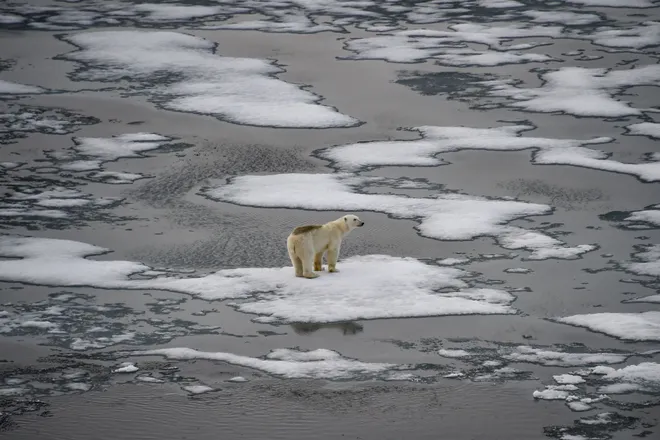Stunning photo of lone polar bear is a reminder: Melting ice is a real threat
A stunning photo of a polar bear drifting off to sleep on a bed of ice won the Natural History Museum's 2023 Wildlife Photographer of the Year award, drawing attention to the plight of polar bears, whose frigid homelands in the Arctic have been eroded by global climate change at an alarming pace.
The touching image shows a polar bear curled up on the side of an iceberg off the Svalbard archipelago, a northern island of Norway past the Arctic circle.
Nima Sarikhani, the photographer who captured the award-winning picture, spent three days looking for polar bears on a ship circling the Norwegian Islands until he came across a pair of bears, according to a Natural History Museum press release. That night, the younger bear carved out a resting place and drifted off, setting the perfect scene for Sarikhani's photo.
See the photo:Photographer Nima Sarikhani named Wildlife Photographer of the Year by The Natural History Museum
"Whilst climate change is the biggest challenge we face, I hope that this photograph also inspires hope," Sarikhani said in a press release. "There is still time to fix the mess we have caused."
The bear captured in the picture is one of an estimated 3,000 bears living in the Barents Sea, which migrate between Svalbard and the Russian Arctic Islands, according to the Natural History Museum.
The polar bears of Svalbard, one of the world's 19 populations, are facing crisis as climate change continues to deteriorate their icy home.
Svalbard has warmed between 5.4 and 9 degrees Fahrenheit in the last half century, thinning out the ice that is crucial to polar bear survival, according to a report commissioned by the Norwegian Environment Agency in 2019. That means bears are forced to swim longer distances and don't have as much contact with others.
Melting ice forces bears to seek food on shore
Todd Atwood, who leads the polar bear research program at the US Geological Survey's Alaska Science Center, said there's not a "homogeneous response by polar bears to changes that occur throughout the Arctic." Still, the continuous melting of ice is taking a toll on some populations.
Climate change news:Melting ice could create chaos in US weather and quickly overwhelm oceans, studies warn
In the southern Beaufort Sea, where he conducts his research, Atwood said bears are doing "relatively poorly" because of the loss of sea ice over their continental shelf.
"Historically, these bears would spend basically most of their year on the sea ice," Atwood said. "Now, upwards of 30% of the population has learned to come ashore during that summer and fall period."
Since food is more scarce on land, polar bears forced to travel ashore are often in a "physiological state of nutritional stress," which could attract them to areas with more people, Atwood said.
Atwood said female bears also could have trouble delivering their cubs safely if they can't feed enough to retain sufficient body mass.
More:Where do polar bears live? Get to know more on the Arctic habitat of the 'sea bear.'
Polar bears face crisis as climate warms
A study released in September of last year revealed the scope of the devastating impact of climate change on polar bear populations. For the first time, researchers directly linked greenhouse gas emissions to their effect on the survival of polar bear cubs.
“We’ve known for decades that continued warming and sea ice loss ultimately can only result in reduced distribution and abundance of polar bears,” said Steven Amstrup of Polar Bear International, the lead author in the study, in a press release. "But until now, we’ve lacked the ability to distinguish impacts of greenhouse gases emitted by particular activities from the impacts of historic cumulative emissions."
The scientists behind the study believe their work can provide a scientific framework for policymakers to strengthen the Endangered Species Act to further protect polar bears.
According to the U.S. Department of the Interior, new fossil fuel and drilling projects must be evaluated independently from historic greenhouse gas emissions.
The researchers believe the study could help the U.S. federal government consider the impacts that fossil fuel projects would have on polar bears when assessing project proposals.

An earlier study led by Amstrup released in 2020 showed that polar bears are at risk of extinction by the end of the century if measures are not taken to curb climate change. Polar bears were the first species to be listed as threatened under the Endangered Species Act because of global warming.
Researchers explored the relationship between the melting ice and periods when the bears were forced to fast. The longer the bears couldn't eat, the more they were at risk for reduced body condition, reproduction and survival.
Amstrup said he hoped the same methodology could be used in the future to help researchers protect other wildlife populations, calling the research "the most important paper of my career."
Atwood said the situation faced by polar bears is not hopeless, if the harm caused by fossil fuel emissions is curbed in time.
"There's still an opportunity for greenhouse gas mitigations to occur that would conserve polar bear habitat and conserve polar bear populations," he said.
Disclaimer: The copyright of this article belongs to the original author. Reposting this article is solely for the purpose of information dissemination and does not constitute any investment advice. If there is any infringement, please contact us immediately. We will make corrections or deletions as necessary. Thank you.





